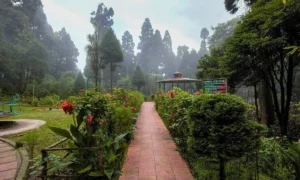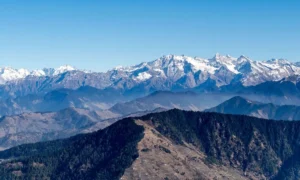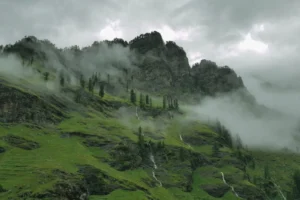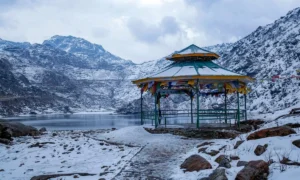Have you ever wondered what it feels like to stand in a place where spirituality, history, and breathtaking beauty all come together? Perhaps you are a traveler looking for a serene escape, a history buff curious about ancient traditions, or a spiritual seeker on a quest for inner peace. Whatever your reason, you may have heard whispers of the magnificent Rumtek Monastery Tourist Place, a true jewel nestled in the hills of Sikkim. It is a place that captivates the mind and calms the soul.
Many people have questions about visiting this incredible site. Where is it located? What is the best time to go? What can you see and do there? This guide is designed to answer all of those questions and more. We will take you on a virtual journey through the rich history of the Rumtek Monastery, its stunning architecture, and the peaceful environment that makes it so special. By the time you are finished reading, you will have all the valuable, actionable information you need to plan your own unforgettable trip. Get ready to explore one of the most important centers of Tibetan Buddhism outside of Tibet.
Exploring the History and Significance of Rumtek Monastery Tourist Place

The Rumtek Monastery, also known as the Dharma Chakra Centre, holds immense spiritual and historical importance. It is the seat of the Karma Kagyu lineage, one of the major schools of Tibetan Buddhism. The monastery’s story began in the mid-1960s when the 16th Karmapa, Rangjung Rigpe Dorje, sought a new home after his exile from Tibet. With the help of the Sikkim royal family and the Indian government, he established this monastery in a location that reminded him of his original home in Tsurphu, Tibet.
The monastery was built with the intention of preserving and promoting the rich cultural and spiritual heritage of the Karma Kagyu lineage. It is a place of learning and practice for monks from all over the world. The stunning architecture and intricate artwork are not merely for decoration; they are deeply symbolic representations of Buddhist teachings. Every statue, every mural, and every stupa tells a story of enlightenment, compassion, and wisdom. This profound connection to the past and its continuous role in shaping the future of Tibetan Buddhism makes it a powerful and revered site.
The Spiritual Heart of Rumtek: The Golden Stupa
One of the most sacred and visually striking features of the monastery is the Golden Stupa. This stupa contains the holy remains of the 16th Karmapa and is an object of deep veneration for followers of the Karma Kagyu tradition. It is adorned with gold and precious stones, a testament to the respect and devotion it commands. Pilgrims and visitors alike come to circumambulate the stupa, offering prayers and showing their reverence. The energy around the stupa is palpable, offering a moment of quiet reflection and spiritual connection.
A Walk Through the Main Shrine
The main shrine, or Dharma Chakra Centre, is the heart of the monastery’s daily life. Inside, you will find a vast and colorful space filled with statues of the Buddha and Bodhisattvas, intricate thangkas (Tibetan Buddhist paintings), and ritual objects. The atmosphere is one of profound peace and devotion. Monks can be seen chanting, praying, and performing daily rituals. Observing these activities provides a window into the disciplined and spiritual life of the monastics. Visitors are encouraged to maintain silence and respect the sanctity of the place. It is a perfect opportunity to sit quietly and simply be present.
Practical Tips for Your Visit to Rumtek Monastery Tourist Place
Planning a trip to the Rumtek Monastery requires some preparation to ensure you have a smooth and enjoyable experience. Here are some key details to help you navigate your journey.
How to Reach Rumtek Monastery
The monastery is located about 24 kilometers from Gangtok, the capital of Sikkim.
- By Air: The nearest airport is Pakyong Airport (PYG) in Sikkim, which is approximately 30 kilometers from Gangtok. Alternatively, Bagdogra Airport (IXB) in West Bengal is a major hub and is about 124 kilometers away. From either airport, you can hire a taxi to Gangtok and then to Rumtek.
- By Road: Gangtok is well-connected by road to major cities like Siliguri and Darjeeling. You can easily hire a taxi from Gangtok to the monastery. The drive takes about an hour, depending on traffic and road conditions. It is important to note that the last few kilometers of the road to the monastery can be steep and winding.
Best Time to Visit Rumtek Monastery
The best time to visit is from October to May. During these months, the weather is pleasant and clear, offering stunning views of the surrounding mountains and valleys. The monsoon season, from June to September, can make the roads difficult to travel due to heavy rainfall and landslides. The winter months from December to February are cold, but the skies are usually clear, providing crisp views of the snow-capped peaks.
Essential Visitor Etiquette
- Dress Code: Visitors are expected to dress modestly. This means covering your shoulders and knees. It is advisable to wear comfortable shoes as you will be doing a lot of walking.
- Photography: While photography is often permitted in the outer courtyards, it is usually prohibited inside the main prayer halls and shrines. It is essential to respect the rules and ask for permission before taking any pictures.
- Silence: Maintain a respectful silence, especially within the prayer halls. This allows monks to perform their rituals without disturbance and other visitors to meditate in peace.
The Art and Architecture of Rumtek
The architecture of the Rumtek Monastery is a beautiful example of traditional Tibetan design, with a touch of modern influence. The buildings are painted in vibrant colors, primarily red and white, and feature intricate carvings and murals. The sloping roofs, tiered structures, and detailed woodwork are all characteristic of Himalayan architecture. The monastery complex includes several buildings, including the main shrine, a monastic college, a stupa, and living quarters for the monks. Each building serves a specific purpose, contributing to the holistic spiritual life of the community.
The Symbolism Behind the Design
Every element of the monastery’s design carries a deep symbolic meaning. The golden roof of the main shrine represents the crown of the Karmapa. The eight auspicious symbols of Buddhism, such as the endless knot and the lotus, are found throughout the complex, each representing a different aspect of the path to enlightenment. The peaceful surroundings, with well-maintained gardens and prayer flags fluttering in the breeze, create an environment that is conducive to contemplation and spiritual growth. The monastery’s serene and powerful presence is a testament to the enduring faith and wisdom of the Karma Kagyu tradition.
FAQs (Frequently Asked Questions) Rumtek Monastery Tourist Place
1. Is there an entry fee for Rumtek Monastery?
No, there is generally no entry fee to visit the monastery. However, visitors may be asked to make a small donation to support the upkeep of the premises.
2. Can tourists stay at the monastery?
No, the monastery does not offer accommodation for tourists. There are several hotels and guesthouses available in and around Gangtok, and some closer to Rumtek village.
3. What are the visiting hours for the monastery?
The monastery is open to visitors daily, usually from 9:00 AM to 5:00 PM. It is advisable to check for any special timings or closures before planning your visit.
4. What is the significance of the prayer flags?
The colorful prayer flags you see around the monastery contain mantras and prayers. It is believed that as the flags flutter in the wind, they carry the prayers and goodwill to all sentient beings, spreading peace and compassion.
5. Are there any special events or festivals at the monastery?
Yes, the monastery celebrates several important Buddhist festivals throughout the year, such as Losar (Tibetan New Year). These events are marked by traditional dances and rituals and are a sight to behold.
Conclusion
Visiting the Rumtek Monastery is an experience that goes far beyond simple sightseeing. It is an opportunity to immerse yourself in a world of spiritual devotion, rich history, and profound peace. We have explored its origins, its spiritual heart, and the practicalities of a visit, providing you with a complete Rumtek Monastery tourist place. From the peaceful aura of the Golden Stupa to the vibrant murals of the main shrine, every part of this sacred site invites you to slow down and reflect.
We encourage you to use this guide to plan your journey and discover this spiritual haven for yourself. Whether you are seeking tranquility, cultural insight, or simply a beautiful escape, Rumtek has something to offer everyone.
What are your thoughts on this incredible destination? Please share your questions or experiences in the comments below. We would love to hear from you.



